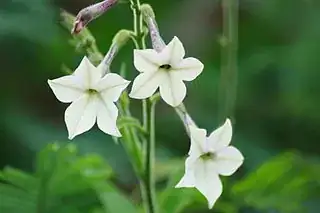First of all, my experience with Nicotiana alata only involves trapping Trialeurodes vaporariorum because my other plants didn't get aphids or mites (yet).
In spring I have received four 6-inch (15 cm) young plants grown outdoors (selfseeded) and then I transplanted them in my closed balcony in a 16*8*8-inch rectangular pot (40*20*20 cm). A little overcrowded in theory, but this didn't stop them to get 3-feet tall (100 cm). I have used the cheapest soil in store, pH 5,5-7, and I haven't fertilized at all.
After a few weeks I have noticed that they began to be filled with Trialeurodes vaporariorum, a few insects on every leaf, and full-packed with insects after two months. In the meantime, the hot peppers (Capsicum annuum) that were attacked every year, had been mostly spared, something like 4-5 insects on every hot pepper plant. Trialeurodes vaporariorum didn't manage to feed too much on the hot peppers, and when I have harvested the fruits, 75% of the leaves were looking fine, with no pesticide applied at all.
One thing that got me puzzled with Nicotiana alata was the need for water, something like every other day when they were young and daily when mature. The explanation might have been the temperature of 104°F (40°C) and the glass that concentrated the rays of light.
As for outdoor cultivation, they are very easy to grow and do not need any care, except for watering maybe. My grandmother lived in a climate of summer drought and wasn't the type to care for flowers. To my surprise, her Nicotiana alata was self-seeding every year in a neglected spot outside her fence, although I have never seen her water the plants. They were getting water only from rain. In our 6b zone Nicotiana alata is an annual plant. Temperatures in summer are frequently 95°F (35°C), and the seeds stay in the ground in winter, under the snow when there is snow, at -13°F (-25°C).
The seeds are very small, a tiny packet might give a hundred seedlings if they all germinate. Commercially available seeds packages state that plants must be distanced at 12-inch (30 cm) between them an 12-inch between rows, and flowers have various colors, whereas all my flowers were white, as they have always been since I was a kid - I don't know if the color matters too much.
